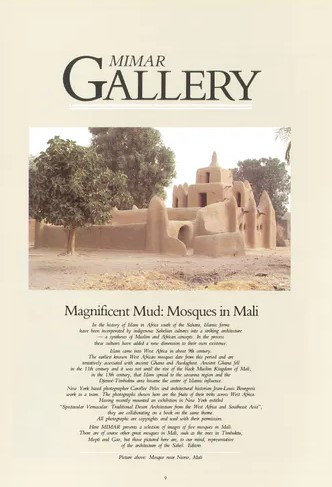
The Magnificent Mud: Mosques in Mali
In the history of Islam in Africa south of the Sahara, Islamic forms
have been incorporated by indigenous Sahelian cultures into a striking architecture
– a syntheses of Muslim· and African concepts. In the process
these cultures have added a new dimension to their own existence.
Islam came into West Africa in about 9th century.
The earliest known West African mosques date from this period and are
tentatively associated with ancient Ghana and Awdaghost. Ancient Ghana fell
in the 11th century and it was not until the rise of the black Muslim Kingdom of Mali,
in the 13th century, that Islam spread to the savanna region and the
Djenne-Timbuktu area became the centre of Islamic irifluence.
New York based photographer Carollee Pelos and architectural historian Jean-Louis Bourgeois
work as a team. The photographs shown here are the fruits of their treks across West Africa.
Having recently mounted an exhibition in New York entitled
“Spectacular Vernacular: Traditional Desert Architecture from the West Africa and Southeast Asia”,
they are collaborating on a book on the same theme.
All photographs are copyrights and used with their permission.
Here MIMAR presents a selection of images of five mosques in Mali.
There are of course other great mosques in Mali, su,h as the ones in Timbuktu,
Mopti and Gao, but those pictured here are, to our mind, representative
of the architecture of the Sahel.
I agree to the terms outlined below:
You agree to upload and assign Mosqpedia Database the rights to use the content worldwide and in perpetuity across all current and future media platforms. Mosqpedia Database may edit, copy, adapt and translate your contribution.
The content will be distributed under the Creative Commons Attribution-Deed – Attribution-NonCommercial-NoDerivatives 4.0 International – Creative Commons
All data will be stored in line with data protection regulations.